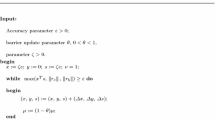Abstract
A new method for obtaining an initial feasible interior-point solution to a linear program is presented. This method avoids the use of a “big-M”, and is shown to work well on a standard set of test problems. Conditions are developed for obtaining a near-optimal solution that is feasible for an associated problem, and details of the computational testing are presented. Other issues related to obtaining and maintaining accurate feasible solutions to linear programs with an interior-point method are discussed. These issues are important to consider when solving problems that have no primal or dual interior-point feasible solutions.
Similar content being viewed by others
References
I. Adler, N. Karmarkar, M.G.C. Resende and G. Veiga, “An implementation of Karmarkar's algorithm for linear programming,”Mathematical Programming 44 (1989) 297–336.
E. Barnes, “A variation on Karmarkar's algorithm for solving linear programming problems,”Mathematical Programming 36 (1985) 174–182.
I.C. Choi, C.L. Monma and D.F. Shanno, “Further development of a primal—dual interior point method,” manuscript, Columbia University (New York, NY, 1988), to appear in:ORSA Journal on Computing.
G.B. Dantzig,Linear Programming and Extensions (Princeton University Press, Princeton, NJ, 1963).
I.I. Dikin, “Iterative solution of problems of linear and quadratic programming,”Soviet Mathematics Doklady 8 (1967) 674–675.
D.M. Gay, “Electronic mail distribution of linear programming test problems,”Mathematical Programming Society COAL Newsletter (December, 1985).
J.A. George and J.W.H. Liu,Computer Solution of Large Sparse Positive Definite Systems (Prentice-Hall, Englewood Cliffs, NJ, 1981).
P.E. Gill, W. Murray, M.A. Saunders, J.A. Tomlin and M.H. Wright, “On projected Newton barrier methods for linear programming and an equivalence to Karmarkar's projective method,”Mathematical Programming 36 (1986) 183–209.
P.E. Gill, W. Murray, M.A. Saunders and M.H. Wright, “A practical anti-cycling procedure for linearly constrained optimization,”Mathematical Progamming 45 (1990) 437–474.
N. Karmarkar, “A new polynomial-time algorithm for linear programming,”Combinatorica 4 (1984) 373–395.
M. Kojima, S. Mizuno and A. Yoshise, “A primal—dual interior point algorithm for linear programming,” in: N. Megiddo, ed.,Progress in Mathematical Programming (Springer, New York, 1988) pp. 29–48.
J.W.H. Liu, “The multifrontal method and paging in sparse Cholesky factorization,” Technical Report CS-87-09, Department of Computer Science, York University (Downsview, Ontario, Canada, 1987a).
J.W.H. Liu, “A collection of routines for an implementation of the multifrontal method,” Technical Report CS-87-10, Department of Computer Science, York University (Downsview, Ontario, Canada, 1987b).
I.J. Lustig, “A generic primal—dual interior point algorithm,” Technical Report SOR 88-3, Program in Statistics and Operations Research, Department of Civil Engineering and Operations Research, School of Engineering and Applied Science, Princeton University (Princeton, NJ, 1988).
I.J. Lustig, “An analysis of an available set of linear programming test problems,”Computers and Operations Research 16 (1989) 173–184.
K.A. McShane, C.L. Monma and D.F. Shanno, “An implementation of a primal—dual interior point method for linear programming,”ORSA Journal on Computing 1 (1989) 70–83.
N. Megiddo, “Pathways to the optimal set in linear programming,” in: N. Megiddo, ed.,Progress in Mathematical Programming (Springer, New York, 1988) pp. 131–158.
C.L. Monma and A.J. Morton, “Computational experience with a dual affine variant of Karmarkar's method for linear programming,”Operations Research Letters 6 (1987) 261–267.
R.C. Monteiro and I. Adler, “Interior path following primal—dual algorithms—Part I: linear programming,”Mathematical Programming 44 (1989) 27–42.
B.A. Murtagh and M.A. Saunders, MINOS 5.1 user's guide, Technical Report SOL 83-20R, Department of Operations Research, Stanford University (Stanford, CA, 1987).
R.J. Vanderbei, M.S. Meketon and B.A. Freedman, “A modification of Karmarkar's linear programming algorithm,”Algorithmica 1 (1986) 395–408.
Author information
Authors and Affiliations
Rights and permissions
About this article
Cite this article
Lustig, I.J. Feasibility issues in a primal-dual interior-point method for linear programming. Mathematical Programming 49, 145–162 (1990). https://doi.org/10.1007/BF01588785
Received:
Revised:
Issue Date:
DOI: https://doi.org/10.1007/BF01588785



